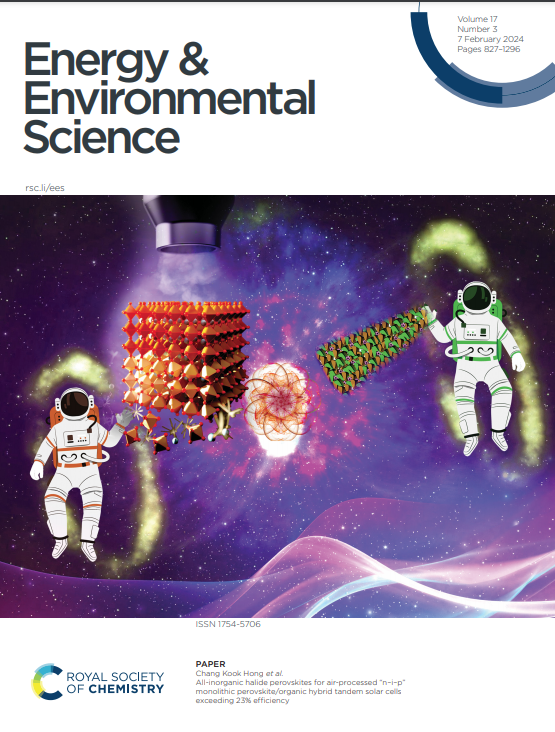负氢介质储放氢研究进展与展望
IF 30.8
1区 材料科学
Q1 CHEMISTRY, MULTIDISCIPLINARY
引用次数: 0
摘要
氢能作为一种清洁能源备受关注,但其大规模应用面临着储存和运输方面的挑战。负氢介质(金属氢化物、硼氢化物)材料因其高效的储氢能力而成为研究热点。研究负氢在材料结构中的作用可以提高我们对氢的各种结构特性的理解,并为设计具有新功能的含氢材料提供有价值的见解。本文综述了近年来负氢介质的研究进展。具体包括氢化镁(MgH2)、氢化铝钠(NaAlH4)、硼氢化锂(LiBH4)、硼烷氨(AB, NH3BH3)、硼氢化钠(NaBH4)、硼氢化钾(KBH4)等。综述了近三年来国内外不同类型的负氢介质储氢和放氢催化剂的催化性能,并分别在纳米尺度和原子尺度上描述了不同类型负氢介质催化剂的结构-性能关系。介绍了单片催化剂和光增强氢释放性能的原因。从计算和实验两方面综述了负氢材料循环再生的研究进展。最后,提出了负氢介质未来面临的主要挑战和发展前景。本文综述有助于对负氢介质催化剂的设计和机理研究有一个基本的认识,并为克服负氢介质催化剂储放氢速率低和循环再生难的问题提供有效的设计原则。本文章由计算机程序翻译,如有差异,请以英文原文为准。
Progress and perspectives on hydrogen storage and release in negative hydrogen medium †
Hydrogen energy has attracted much attention as a clean energy source, but its large-scale application faces storage and transportation challenges. Negative hydrogen medium (metal hydrides, borohydrides) materials have become a research hotspot due to their efficient hydrogen storage capacity. Investigating the role of negative hydrogen in the structure of materials can improve our understanding of the various structural properties of hydrogen and provide valuable insights into the design of hydrogen-containing materials with new functionalities. This paper reviews the research progress of negative hydrogen medium in recent years. Specifically, they include the magnesium hydride (MgH2), sodium aluminum hydride (NaAlH4), lithium borohydride (LiBH4), ammonia borane (AB, NH3BH3), sodium borohydride (NaBH4), potassium borohydride (KBH4), and so on. The catalytic performance of different catalysts used for hydrogen storage and release in negative hydrogen medium in the last three years is summarized, and the structure-performance relationship of different catalysts for negative hydrogen medium is also described on the nanoscale and atomic scale, respectively. The reasons for the monolithic catalysts and light-enhanced hydrogen release performance are also described. The research progress on the cycle regeneration of negative hydrogen materials is summarized from both computational and experimental perspectives. Finally, the main challenges and development prospects of negative hydrogen medium in the future are put forward. This review contributes to a basic understanding of the design and mechanistic studies of negative hydrogen medium catalysts and provides effective design principles for overcoming the problems of low rates of hydrogen storage and release and the difficulty of cyclic regeneration.
求助全文
通过发布文献求助,成功后即可免费获取论文全文。
去求助
来源期刊

Energy & Environmental Science
化学-工程:化工
CiteScore
50.50
自引率
2.20%
发文量
349
审稿时长
2.2 months
期刊介绍:
Energy & Environmental Science, a peer-reviewed scientific journal, publishes original research and review articles covering interdisciplinary topics in the (bio)chemical and (bio)physical sciences, as well as chemical engineering disciplines. Published monthly by the Royal Society of Chemistry (RSC), a not-for-profit publisher, Energy & Environmental Science is recognized as a leading journal. It boasts an impressive impact factor of 8.500 as of 2009, ranking 8th among 140 journals in the category "Chemistry, Multidisciplinary," second among 71 journals in "Energy & Fuels," second among 128 journals in "Engineering, Chemical," and first among 181 scientific journals in "Environmental Sciences."
Energy & Environmental Science publishes various types of articles, including Research Papers (original scientific work), Review Articles, Perspectives, and Minireviews (feature review-type articles of broad interest), Communications (original scientific work of an urgent nature), Opinions (personal, often speculative viewpoints or hypotheses on current topics), and Analysis Articles (in-depth examination of energy-related issues).
 求助内容:
求助内容: 应助结果提醒方式:
应助结果提醒方式:


